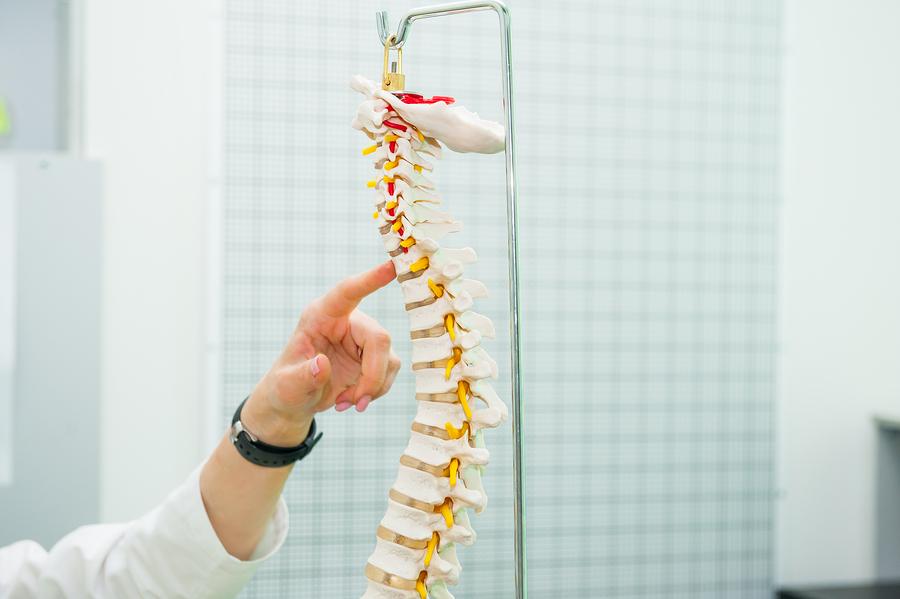
The spine is one of the most important parts of the human body and is comprised of 33 different bones. Your spine enables you to stand up, and without it you would be unable to twist or move your body.
You may think of the spine as being straight, but it actually has a natural ’S’ shape. Natural curves occur at the neck and the lower back, as well as in the thoracic and sacral points. These curves are quite beneficial to the overall health of the spine. This is because they help to prevent damage from shock, as well as better allowing movement throughout the rest of the spine.
Maintaining a correct posture will go a long way to helping preserve the optimum health of your spine. Placing strain on the spine through heavy lifting or excessive unnatural movements is a bad idea and can lead to problems over time. Being overweight or having weak muscles can also cause the spine to become misaligned. When your spine comes out of alignment it will come under serious strain, leading to further complications.
Vertebrae
The 33 different bones in your spine are referred to as the vertebrae. These vertebrae connect with each other to form what is known as the spinal column. There are five different regions of the spinal column, and they are separately known as cervical, thoracic, lumbar, sacrum and coccyx. Although the top 24 bones of the spinal column are able to move, the bottom nine are static.
Each of the bones in your spine is protected by an intervertebral disc. This disc prevents the bones from rubbing against each other. Each disc has a soft gel center, known as the nucleus, and a much tougher outer layer, known as the annulus. As you age, your discs will become less effective at doing their job and will become flatter and brittle. This reduction of the discs is actually why people become shorter as they age!
If one of the spinal bones collapses then this is known as a vertebrae fracture. This is something that is not uncommon in people who suffer from osteoporosis. This is because of the detrimental effect that this condition has on the strength and density of the bones.
The Spinal Cord
The spinal cord is approximately 18 inches long and just slightly thicker than a finger. It is protected by the spinal column and runs from the brain stem down to the 1st lumbar vertebra. When the spinal cord ends, the fibers separate and continue to connect down to the tailbone, and then down through the legs to your feet.
The job of the spinal cord is to send information from the brain to the rest of the body. These messages from the brain then become movement and action in the areas of the body to which they are sent. Messages are also sent from the limbs, and other areas of the body, to the brain in regards to the things that we touch and feel. In certain situations the spinal cord is able to act without a message from the brain, such as when there is a perceived danger or threat. This is known as a spinal reflex and serves to protect the body from damage.
If the spinal cord does become damaged, most likely as the result of an accident or other injury, then it is possible that the area below the site of the injury can be seriously affected. This could range from a partial loss of sensory and motor functions to complete paralysis. Although there is no cure for permanent paralysis there are ways that a person can adapt to life with this new loss of ability.
The Spinal Column
The spinal column protects the spinal cord from damage, so it is imperative that the spinal column is as healthy as possible. The health of the spinal column is affected by several contributing factors, such as muscle mass and bone strength, as well as the health of your ligaments, tendons and nerves. When any of these things are comprised, such as by injury or an illness, then pain can occur in the spine.
Muscles
There are two main muscle groups that affect the spine. They are known as flexors and extensors. Flexor muscles are those at the front of the body and they allow you to bend forwards. The flexor muscles are also important when it comes to lifting things, as well as maintaining control of the lower back. The extensor muscles are at the back of the body and allow you to stand up. They are also important for enabling you to lift things.
Protecting Your Spine
The continued good health of your spine is important for an abundance of reasons, and will help you to retain your mobility and independence as you age. The best ways to protect your spine are to get an adequate amount of sleep each night in a comfortable position, exercise regularly, wear comfortable footwear and limit the amount of time that you spend sitting down.
References
Related Posts
Cigarettes May Inhibit Inflammation Treatments
Axial spondyloarthritis, also known as AxSpa, is a chronic…








